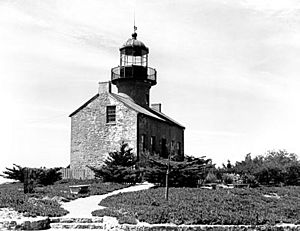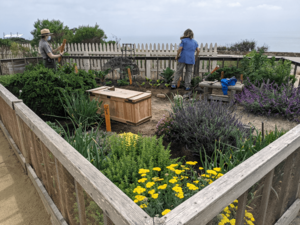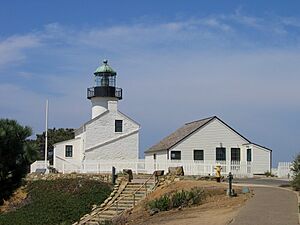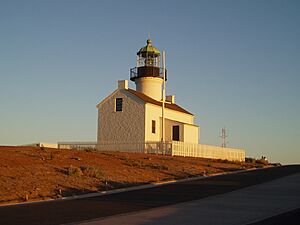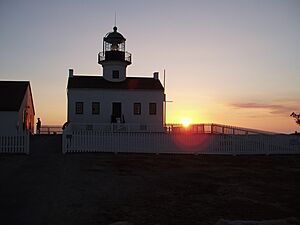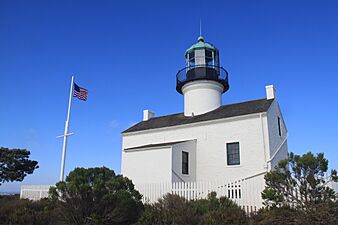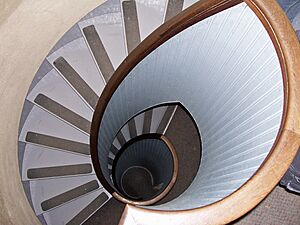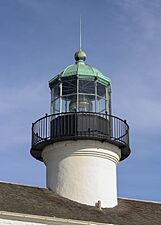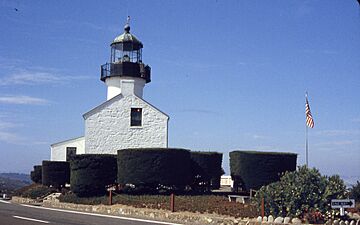Old Point Loma Lighthouse facts for kids
| Location | Cabrillo National Monument |
|---|---|
| Year first lit | 1855 |
| Deactivated | 1891 |
| Height | 46 feet (14 m) |
| Focal height | 462 feet (141 m) |
| Original lens | Third-order Fresnel lens |
The Old Point Loma Lighthouse is a famous old lighthouse located on the Point Loma peninsula in San Diego, California. It sits at the entrance to San Diego Bay. Today, it no longer guides ships but is a popular museum. You can find it inside Cabrillo National Monument.
Some people mistakenly call it the "Old Spanish Lighthouse." However, it was actually built in 1855 by the United States government. This was after California became a state, not during the Spanish or Mexican times.
Contents
History of the Lighthouse
After California joined the United States in 1850, the government decided to build lighthouses along its coast. These lights were important for guiding ships safely. In 1850, Congress set aside money for this project. More money was added in 1854 to finish the work.
Point Loma was chosen as a lighthouse spot in 1851. Construction began in April 1854. The special lantern and lens, which came all the way from Paris, France, arrived in August 1855. The lighthouse was finished by October 1855. Its light shone for the very first time on November 15, 1855.
When the lighthouse was built, a smaller building was also put up next to it. This building first stored oil and other supplies. Later, in 1875, part of it became a small apartment for the assistant lighthouse keeper. Today, this building is also a museum. It holds the original lens from the newer Point Loma lighthouse and other historical items.
Why the Lighthouse Moved
The Old Point Loma Lighthouse was built very high up, on top of a 400-foot cliff. This made it the highest lighthouse in the United States at the time. However, this high location caused a problem: fog and low clouds often blocked the light. Ships couldn't see it when the weather was bad. Sometimes, the lighthouse keeper even had to fire a shotgun to warn ships away!
Because of the fog problem, the light was turned off for good on March 23, 1891. A new lighthouse, called the New Point Loma lighthouse, was built at a lower spot closer to the water. This new light could be seen more easily through the fog.
From Lighthouse to Monument
After the lighthouse was no longer used, it started to fall apart. In 1913, President Woodrow Wilson made the lighthouse and the land around it a national monument. This was done to honor Juan Rodriguez Cabrillo, an explorer who sailed to San Diego.
In 1935, the lighthouse was fixed up and looked like new again. A statue of Cabrillo, given by the government of Portugal, was placed near the lighthouse in 1949. In 1984, the lighthouse light was turned on again for one day. This celebrated its 130th birthday. Many people, including over 100 family members of past lighthouse keepers, came to the event.
Lighthouse Keepers
Lighthouse keepers were the people who lived at the lighthouse and made sure the light was always working. They had a very important job guiding ships. Here are some of the people who served as keepers at the Old Point Loma Lighthouse:
- James P. Keating (1854–1859)
- H. C. Wiley (1859)
- J. N. Covarrubias (1859–1860)
- Joseph Renier (1860)
- James P. Keating (1860–1861)
- W. C. Price (1861–1867)
- J. D. Jenkins (1867–1871)
- Enos A. Wall (1871–1872)
- James J. Ferra (1872–1873)
- Robert D. Israel (1873–1891)
Robert Israel: A Dedicated Keeper
Robert Decatur Israel was the lighthouse keeper for the longest time, serving for 18 years. He was born in Pennsylvania in 1826. He moved to San Diego in 1848 and worked as a blacksmith.
Robert Israel married Maria Arcadia Alipas Machado in 1852. Maria was from a well-known San Diego family. They had four children. Like many wives of lighthouse keepers, Maria also worked as an assistant keeper.
The Israel family lived alone at Point Loma. Their job was to make sure the lighthouse light shone every night. They spent 18 years there, watching their children and grandchildren grow up. One of their grandsons was even born at the lighthouse!
When the new lighthouse was built in 1891, Robert Israel became its keeper. However, he was dismissed from this role in 1892. He passed away in 1908 and is buried in Fort Rosecrans National Cemetery. Today, some of his family members volunteer at the lighthouse. They help bring its history to life for visitors.
Life at the Lighthouse
The Old Point Loma Lighthouse was more than just a light tower. It was also a home for the keepers and their families. Visitors today can explore some of the rooms to imagine what life was like there.
The Israel family, with their three sons and a niece, lived a busy life at the lighthouse. They grew vegetables in a garden, kept horses, and raised chickens, pigs, and goats. The children would row across the bay every day to go to school in Old Town. Sometimes, people from town would visit the lighthouse by horse and buggy. They would have picnics and spend time with the keepers.
After the Light Went Out
After the lighthouse was no longer used for guiding ships, it started to get old and worn down. In 1913, the land around the lighthouse was made into Cabrillo National Monument. This was done to honor the explorer Juan Rodríguez Cabrillo.
The lighthouse was restored in 1935 and looked like it did when it was first built. During World War II in 1941, the lighthouse was painted camouflage green. It was used as a signal tower to help direct ships into San Diego Harbor.
After the war, the lighthouse became a museum again. In the 1980s, it was restored to look like the Israel family's home. It was filled with furniture from that time. More recently, the area around the lighthouse was also restored. It now has native plants, a vegetable garden, and a system to collect rainwater. The lantern room now holds a special lens from another lighthouse called Mile Rocks.
The Lighthouse Today
Today, the Old Point Loma Lighthouse is a famous landmark and a museum. Visitors can go inside and see parts of the living areas. Sometimes, you might even meet volunteer actors dressed as historical figures. These include "Captain Israel," who was a real lighthouse keeper, or "members of the crew" from Cabrillo's ship.
The very top of the lighthouse, the tower, is usually closed to the public. But it opens twice a year for special occasions! These days are August 25th, which is the National Park Service's Birthday, and November 15th, which is the Lighthouse's Anniversary.
Interesting Facts
- The Old Point Loma Lighthouse was one of the first eight lighthouses built on the Pacific Coast.
- It was first lit on November 15, 1855.
- The special lens inside the lighthouse was called a "third-order Fresnel lens." It was bought from Paris, France, for $3,810.
- The light was 462 feet (about 141 meters) above sea level.
- Ships could see the light from about 28 miles (45 kilometers) away.
- The lighthouse used different types of oil for its light, including sperm whale oil and kerosene.
- The lighthouse was restored by the National Park Service in 1935.
- The lens currently on display in the lighthouse tower is from the Mile Rocks Lighthouse.
See also
 In Spanish: Faro de Point Loma para niños
In Spanish: Faro de Point Loma para niños
- List of lighthouses in the United States
- Cabrillo National Monument
- New Point Loma lighthouse
Gallery


